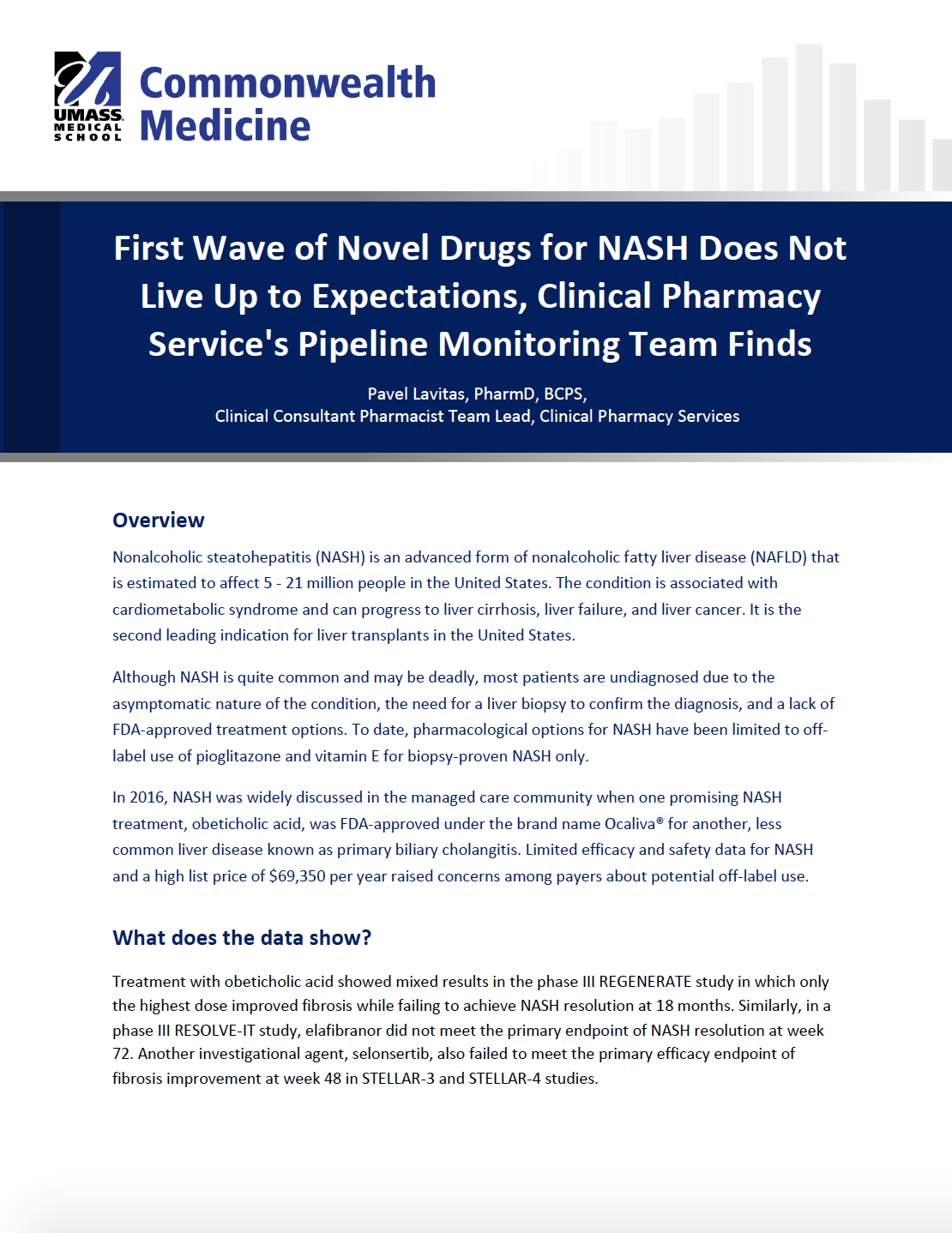First Wave of Novel Drugs for NASH Does Not Live Up to Expectations,
Clinical Pharmacy Service’s Pipeline Monitoring Team Finds
Pavel Lavitas, PharmD, BCPS
Clinical Consultant Pharmacist Team Lead, Clinical Pharmacy Services
Nonalcoholic steatohepatitis (NASH) is an advanced form of nonalcoholic fatty liver disease (NAFLD) that is estimated to affect 5 – 21 million people in the United States. The condition is associated with cardiometabolic syndrome and can progress to liver cirrhosis, liver failure, and liver cancer. It is the second leading indication for liver transplants in the United States.
Although NASH is quite common and may be deadly, most patients are undiagnosed due to the asymptomatic nature of the condition, the need for a liver biopsy to confirm the diagnosis, and a lack of FDA-approved treatment options. To date, pharmacological options for NASH have been limited to off-label use of pioglitazone and vitamin E for biopsy-proven NASH only.
In 2016, NASH was widely discussed in the managed care community when one promising NASH treatment, obeticholic acid, was FDA-approved under the brand name Ocaliva® for another, less common liver disease known as primary biliary cholangitis. Limited efficacy and safety data for NASH and a high list price of $69,350 per year raised concerns among payers about potential off-label use.
What does the data show?
Treatment with obeticholic acid showed mixed results in the phase III REGENERATE study in which only the highest dose improved fibrosis while failing to achieve NASH resolution at 18 months. Similarly, in a phase III RESOLVE-IT study, elafibranor did not meet the primary endpoint of NASH resolution at week 72. Another investigational agent, selonsertib, also failed to meet the primary efficacy endpoint of fibrosis improvement at week 48 in STELLAR-3 and STELLAR-4 studies.
In June 2020, the FDA issued a Complete Response Letter regarding the New Drug Application for obeticholic acid to treat fibrosis due to NASH, noting that the drug’s predicted benefit does not outweigh potential risks. In July 2020, the manufacturer of elafibranor terminated the Phase III RESOLVE-IT study as the results were unlikely to provide sufficient support for drug approval.
What value does obeticholic acid offer to payers for NASH?
A 2016 cost-effectiveness analysis of obeticholic acid for NASH based on data from a phase II study conducted by the Institute for Clinical and Economic Review found that a discount of more than 90 percent from the annual list price would be required to achieve a cost-effectiveness ratio of $150,000/quality adjusted life year.
Using disease prevalence data and predicted cost information for reference therapies from other disease states, the Commonwealth Medicine Clinical Pharmacy Services team produced an annualized budget impact forecast of $0.18 to $0.32 per member per year for a health plan with 100,000 members (Table 1).
Table 1. Annualized Budget Impact (100,000 Member Plan)
Dispelling the hype around the first wave of NASH drugs
Although novel therapies hold the promise of halting the progression of liver fibrosis and preventing NASH complications, to date, the data has been mixed, and many questions remain. What is the long-term safety of these drugs, and what is their impact on mortality and liver-related complications? Who are the ideal candidates for treatment, and can they be identified using noninvasive diagnostic tools? Will patients remain adherent to potentially life-long therapy for an asymptomatic condition?
Despite unfavorable study results highlighted above, the NASH pipeline is rich. With the prevalence of NASH forecast to increase by 63 percent over the next decade and the potential for high drug costs, NASH drugs will represent a challenge for payers once the FDA approves them. If cenicriviroc and resmetirom continue to progress in development, they may become the first drugs approved for NASH in 2021 or 2022. Combination therapy is also being actively studied, which may increase drug costs.
Although they were much-hyped, the first wave of novel NASH drugs did not live up to expectations. The result highlights the need for continued monitoring and comprehensive assessment of clinical trial and cost-effectiveness data to ensure future NASH therapies offer value to payers. Possible drug management strategies that should be considered by payers include prior authorization requirements to confirm the diagnosis, promote adherence to the labeled drug indications, and ensure specialist consultation, as well as a refill reminder outreach.
How can we help you stay on top of the latest developments in the drug pipeline?
As part of our comprehensive drug pipeline monitoring and budget impact forecasting program, the Clinical Pharmacy Services team closely follows NASH drugs and many others currently in development.
To learn more about pipeline intelligence and budget impact forecasting services offered by Clinical Pharmacy Services, contact Bonnie Greenwood, PharmD, BCPS, Director, Clinical Programs.
References:
- Younossi ZM, Koenig AB, Abdelatif D, Fazel Y, Henry L, Wymer M. Global epidemiology of nonalcoholic fatty liver disease-Meta-analytic assessment of prevalence, incidence, and outcomes. Hepatology. 2016 Jul;64(1):73-84.
- Chalasani N, Younossi Z, Lavine JE, Charlton M, Cusi K, Rinella M, et al. The diagnosis and management of nonalcoholic fatty liver disease: Practice guidance from the American Association for the Study of Liver Diseases. Hepatology. 2018 Jan;67(1):328-357.
- Ocaliva® [package insert]. New York (N.Y.): Intercept Pharmaceuticals, Inc; 2020 Feb.
- New England Comparative Effectiveness Public Advisory Council (CEPAC). Obeticholic Acid for the Treatment of Primary Biliary Cholangitis: Comparative Clinical Effectiveness, Value, and Value-Based Price Benchmarks. 2016 July 26 [cited 2020 Oct 2]. Available from: https://icer-review.org/wp-content/uploads/2016/07/NECEPAC_OCA_PBC_Evide….
- Ioannou L. The $35 billion race to cure a silent killer that affects 30 million Americans. Published December 30, 2018 [cited 2020 Oct 2]. Available from: https://www.cnbc.com/2018/12/21/the-35-billion-race-for-a-cure-for-a-liv….
- ClinicalTrials.gov [Internet]. Bethesda (MD): National Library of Medicine (US). 2000- [cited 2019 Nov 1]. Available from: http://clinicaltrials.gov.
- Neuschwander-Tetri BA, Loomba R, Sanyal AJ, Lavine JE, Van Natta ML, Abdelmalek MF, et al. Farnesoid X nuclear receptor ligand obeticholic acid for non-cirrhotic, nonalcoholic steatohepatitis (FLINT): a multicentre, randomised, placebo-controlled trial. Lancet. 2015 Mar 14;385(9972):956-65.
- Ratziu V, Harrison SA, Francque S, Bedossa P, Lehert P, Serfaty L, et al. Elafibranor, an Agonist of the Peroxisome Proliferator-Activated Receptor-α and -δ, Induces Resolution of Nonalcoholic Steatohepatitis Without Fibrosis Worsening. Gastroenterology. 2016 May;150(5):1147-1159.e5.
- Noncirrhotic Nonalcoholic Steatohepatitis With Liver Fibrosis: Developing Drugs for Treatment. Draft Guidance for Industry. Rockville (M.D.): Food and Drug Administration (U.S.); https://www.fda.gov/media/119044/download.
- Younossi ZM, Ratziu V, Loomba R, Rinella M, Anstee QM, Goodman Z, et al. Obeticholic acid for the treatment of nonalcoholic steatohepatitis: interim analysis from a multicentre, randomised, placebo-controlled phase 3 trial. Lancet. 2019 Dec 14;394(10215):2184-2196.
- GENFIT: Announces Results from Interim Analysis of RESOLVE-IT Phase 3 Trial of Elafibranor in Adults with NASH and Fibrosis [press release on the Internet]. Lille (France), Cambridge (MA): Genfit; 2020 May 11 [cited 2020 Oct 2]. Available from: https://www.globenewswire.com/news-release/2020/05/11/2031418/0/en/GENFI….
- Gilead Announces Topline Data From Phase 3 STELLAR-3 Study of Selonsertib in Bridging Fibrosis (F3) Due to Nonalcoholic Steatohepatitis (NASH) [press release on the Internet]. Foster City (C.A.): Gilead Sciences Inc; 2019 Apr 25 [cited 2020 Oct 2]. Available from: https://www.gilead.com/news-and-press/press-room/press-releases/2019/4/g….
- Gilead Announces Topline Data From Phase 3 STELLAR-4 Study of Selonsertib in Compensated Cirrhosis (F4) Due to Nonalcoholic Steatohepatitis (NASH) [press release on the Internet]. Foster City (C.A.): Gilead Sciences Inc; 2019 Feb 11 [cited 2020 Oct 2]. Available from: https://www.gilead.com/news-and-press/press-room/press-releases/2019/2/g….
- Intercept receives complete response letter from FDA for obeticholic acid for the treatment of fibrosis due to NASH [press release on the Internet]. New York (N.Y.): Intercept Pharmaceuticals, Inc.; 2020 June 29 [cited 2020 Oct 2]. Available from: https://ir.interceptpharma.com/news-releases/news-release-details/interc…
- GENFIT Scraps Elafibranor in NASH, Sets New Strategic Focus [press release on the Internet]. Urbandale (I.A.): Biospace, Inc.; 2020 July 23 [cited 2020 Oct 2]. Available from: https://www.biospace.com/article/genfit-scraps-elafibranor-nash-program-….
- Estes C, Razavi H, Loomba R, Younossi Z, Sanyal A.J. Modeling the epidemic of nonalcoholic fatty liver disease demonstrates an exponential increase in burden of disease. Hepatology. 2018 Jan;67(1):123-133.


